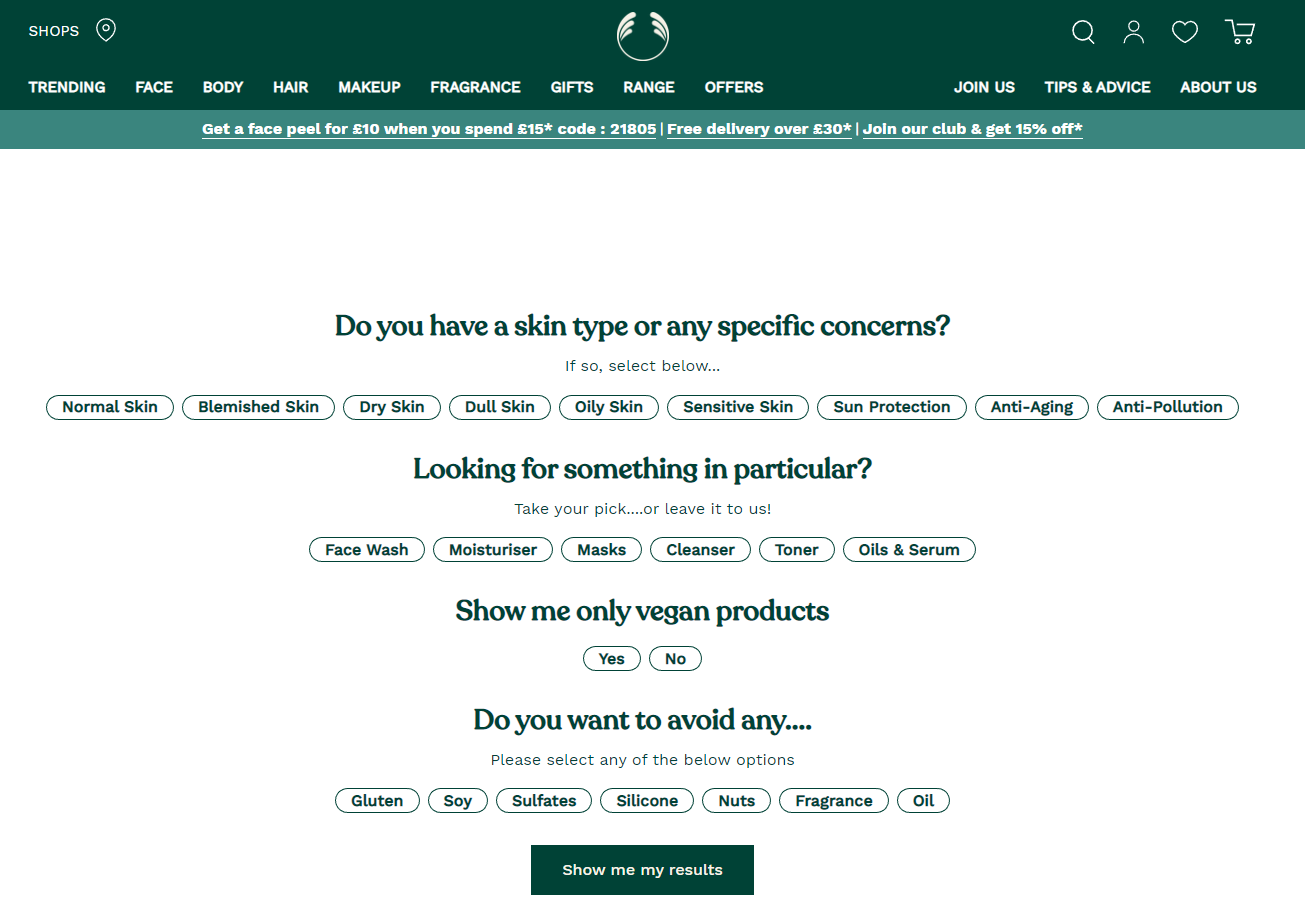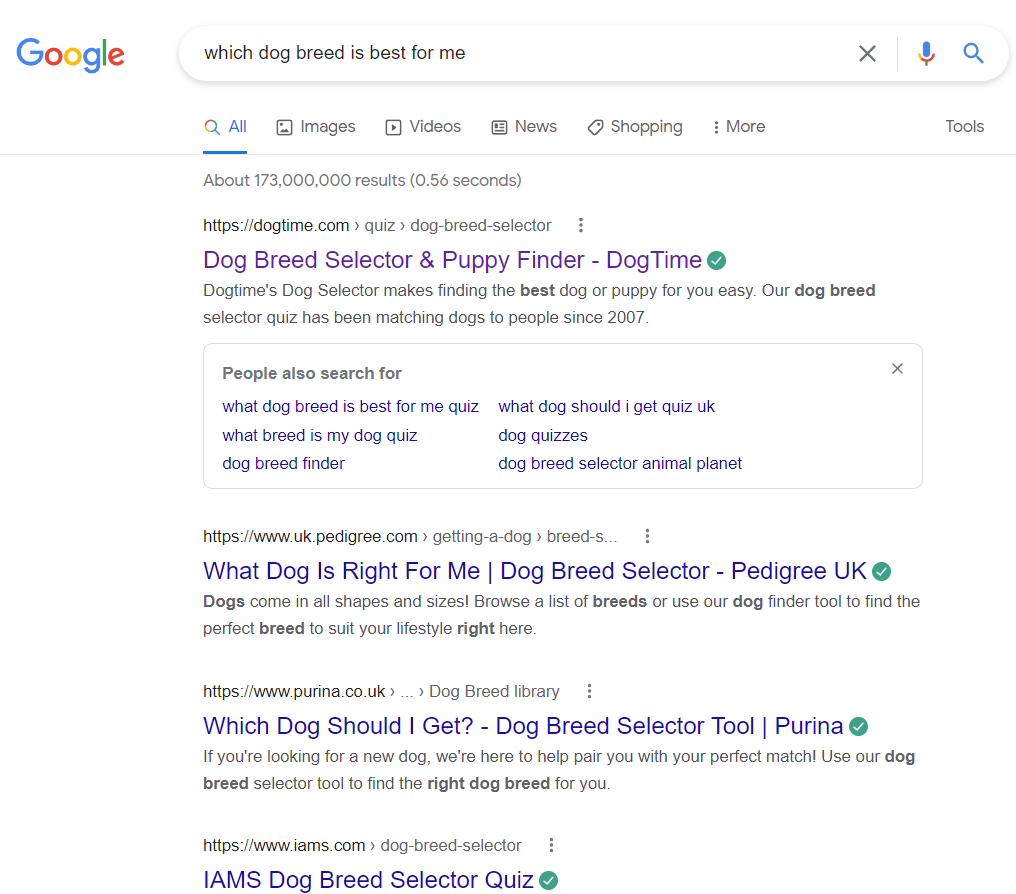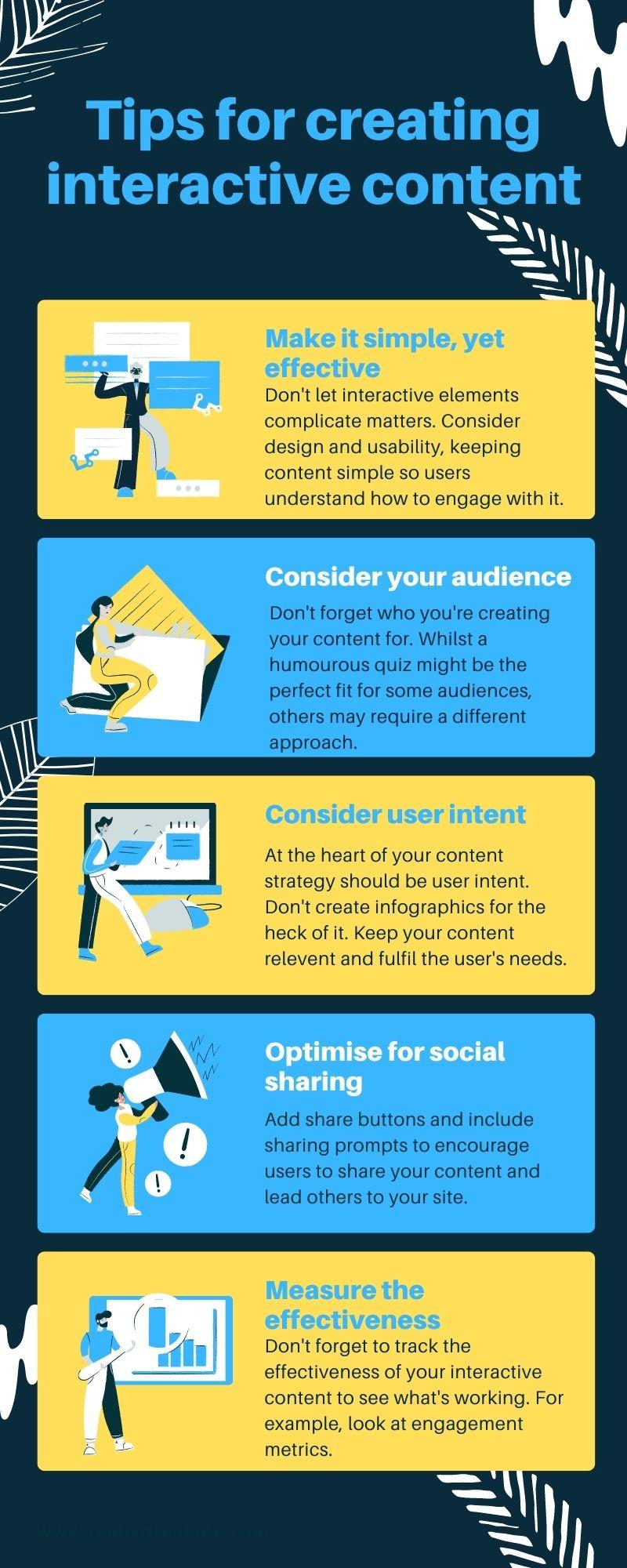Keeping your audience engaged is vital if you want to keep them coming back for more. In this article we’ll share the ways interactive content can impact your SEO efforts and what you can do to maximise results from your content.
Yes, keywords and link building play an important role in your SEO strategy, but maybe it’s time for you to dip your toe into the realm of interactive content.
What is interactive content?
Interactive content is essentially the features on your site which users can engage with, this can take the form of:
- Surveys and polls
- Quizzes
- Interactive infographics
- Interactive emails
- Interactive calculators
- And much more!
Essentially, it’s content that enables users to interact with it, in a fun and often customised way which entices them to spend more time on your site.
Let’s look at some examples of how brands have incorporated interactive content to their website or app:
The Body Shop
Everyone's skin is different - not only does The Body Shop recognise this, they created a skincare finder which asks the user a number of questions about their skin, allergies, whether they only want vegan products and if they’re looking for a particular product. This is a great website feature as not only is it a more fun and personalised way to shop, it helps to ensure the user finds the right product for them - it considers their individual needs.

ASOS
Don’t you just hate ordering online and it not fitting the way you thought it would? ASOS has built an in-app tool which helps their customers to find the right clothing size for them (based on information on the clothing as well as user buying history). Not only is this super useful for consumers, it offers a more personalised shopping experience.

MINI
Another great example of brands making their content more interactive and personalised is MINI offering customers the chance to choose and customise a car based on their personal taste, budget and needs. Users simply choose the model of MINI they would like, edit their selection (i.e. selecting a different colour or adding additional features) and get a summary of price and finance details. They can then decide if they wish to go ahead with the purchase, request a test drive, reserve the vehicle or get more information. The details of the user’s car configuration is saved for 30 days which makes it easy for them to jump back to the same position of the purchasing funnel they were in - plus, MINI will discover useful information about user preferences which could inform their marketing decisions and product development in future.
Ways interactive content can impact SEO
Now, let’s dive into the benefits of interactive content for SEO…
1. It can improve user engagement
Having positive user engagement isn’t just important from an SEO perspective, it highlights the level to which users are interacting with your brand. If you want to grow your business, engaging those that land on your site will encourage them to stay on site for longer, give you their personal information and invest in your products or services.
Captivate your audience with materials that they’re less likely to see elsewhere, as this will give you a competitive edge. In fact, 88% of marketers believe that having interactive content helps to differentiate themselves from competitors.For example, if you include a mini survey on your page about a product, users may feel more valued, and feel that your brand is willing to listen to their views (aside from this, you could gain valuable insights and d-d-d-data!).
Creating personalised content is also incredibly effective. In fact, according to a survey by Think With Google, 90% of leading marketers stated that personalisation increased business profitability.
At the end of the day, it’s the engaged users who are most likely to go on to become your very own army of brand ambassadors, sharing your content online and spreading good word about you.
2. You can earn more backlinks
Backlinks are still an important part of driving traffic to your site and building authority but you may have already discovered how challenging they are to acquire (good ones that don’t involve black hat SEO tactics that is!). Well, one way to earn yourself quality backlinks is to create interesting and interactive content that stands out from the crowd. If your content is stale and static, why would anyone want to link to it?
Once you’ve gained valuable backlinks, you’ll reap the reward of increased traffic and better E-A-T signals which can improve your rankings.
3. It can step up your social media strategy
Having people share your content on social media isn’t a direct organic ranking factor, however, if you can build social shares it will work in a similar way to backlinks and help to increase your online visibility. Social media posts that grab attention can point users to your site, increase brand awareness and eventually lead to more conversions.
Looking to step up your social media strategy? Check out our social media advertising services to see how we can help.
4. You can gain valuable data
Certain interactive features can capture useful information about your customers which you may not get from your average metrics. For example, running a poll or survey will allow you to collect answers from users who respond to them (such as product preferences) which can then be used to inform future ad campaigns, impact decisions made during product development and highlight the type of content you should be optimising to improve organic performance. Moreover, if users willingly give you their details because they’re getting something in return (perhaps an indication of how many euros they should take on their holiday with the help of a budget calculator you feature on your travel site), you’ll be generating more leads than you would with static content.
5. It may be better tailored to user intent
Understanding user intent and optimising your content for what users really want is imperative for SEO, especially with Google’s MUM update on the horizon. Interactive content can better meet user intent if it helps to serve the webpage’s purpose. For example, when I search ‘which dog breed is best for me’, the results are all for dog breed selector tools and quizzes - interactive content pieces that meet my informational intent of finding the right dog for me based on how much I exercise, what size dog I’d like, how much I’m home and more.

6. Search metrics
Having engaging, high-quality content can help to improve your rankings, and this will be evident when looking at search metrics such as:
- The time people are spending on your page.
- Page visits (how many pages of your site the user checks out).
- Bounce rate - this is the amount of visitors who navigate away from your site after just viewing one page. If you have a high bounce rate, perhaps your content isn’t engaging enough.
That said, Google Analytics 4 (GA4) will show you different metrics to indicate user engagement. A session would be considered engaging if a user converts, has two or more page views or interacts with your site for longer than 10 seconds. These metrics include:
- Engaged sessions (how many sessions saw one of the actions mentioned above).
- Engagement rate (this is essentially taking over the bounce rate which is seen in Google Analytics Universal and indicates how often visitors stay on your site and interact with it opposed to just showing you how often they leave the site).
- Engagement time (the total ‘engagement time’ spent on your website or app).
- Engaged sessions per user (the number of engaged sessions/total users on your site.
Essentially, what these metrics tell you is that the people landing on your site are having a positive experience.
How to create interactive content
Having interactive content on your landing pages will help to improve time users spend on site and increase KPI, but even creating interactive content for your email marketing, social media platforms and paid ads will help to increase brand awareness and enhance your brand visibility - which can also help your SEO as a result.
When it comes to creating interactive content, there’s a lot of options out there, and popular tools to help you do it include:
- Canva - this is a very popular tool for creating infographics with interactive elements.
- Contenttools - this is a tool for creating both static and dynamic content and enables you to create content in a range of formats, including quizzes, infographics, maps and more.
- Survey Monkey - you’ve probably been asked to answer a few questions on Survey Monkey yourself, and it’s a simple way to create interactive surveys, quizzes and other tests to gain valuable data from respondents.
- Calculoid - as the name suggests, this is a tool for creating interactive calculators.
Here are a few tips for creating interactive content:

- Don’t over-complicate your content, keep it simple - users should be able to understand the purpose of your content and how to interact with it. Test it out - if it’s not giving the user a simple answer or catering to their needs then simplify it.
- Consider your audience - ensure that your content is created and optimised for the right people. Sure, a quiz about your favourite Twilight character could be fun, but will your audience understand the reference and have you adopted the right tone of voice?
- Consider user intent - there’s a reason behind each and every search, and you want to ensure your content matches what the user is looking for. Aim to fulfil the user’s needs rather than creating an infographic that isn’t relevant to the meaning of their search. You can learn more about search intent here.
- Optimise your content for social media - you’ve created some killer content, why not share it? Make sure your content is easily shareable by adding share buttons and encouraging users to spread the word. The more compelling your content is, the more likely people are to want to show it off with friends, family and colleagues.
- Measure the effectiveness of your content - after putting in all the hard work, check out engagement metrics to see what users are responding positively to. Perhaps you’ll discover landing pages that could use a little TLC with interactive elements which will up the ante in terms of traffic, goals and conversions.
Final thoughts
So, there you have it, interactive content could be the way forward if you’re looking to evolve your SEO strategy and keep your audiences engaged. That said, incorporating interactive elements to your site may prove to be more challenging if you’re not tech savvy or if you don’t have a creative team of developers and web designers who can bring your ideas to life.
Despite the challenge of additional time, effort and resources, creating engaging and interactive content could really pay off and give you a competitive edge. SEO is becoming increasingly more competitive and you need to investigate ways to work with algorithm updates and keep up in a saturated market.
Here at Adido, we can help you to shape your content strategy and increase the effectiveness of your SEO campaigns. Speak to an SEO specialist today or contact us to see how our web designers, web developers and technical SEO team can add impact to your site.




